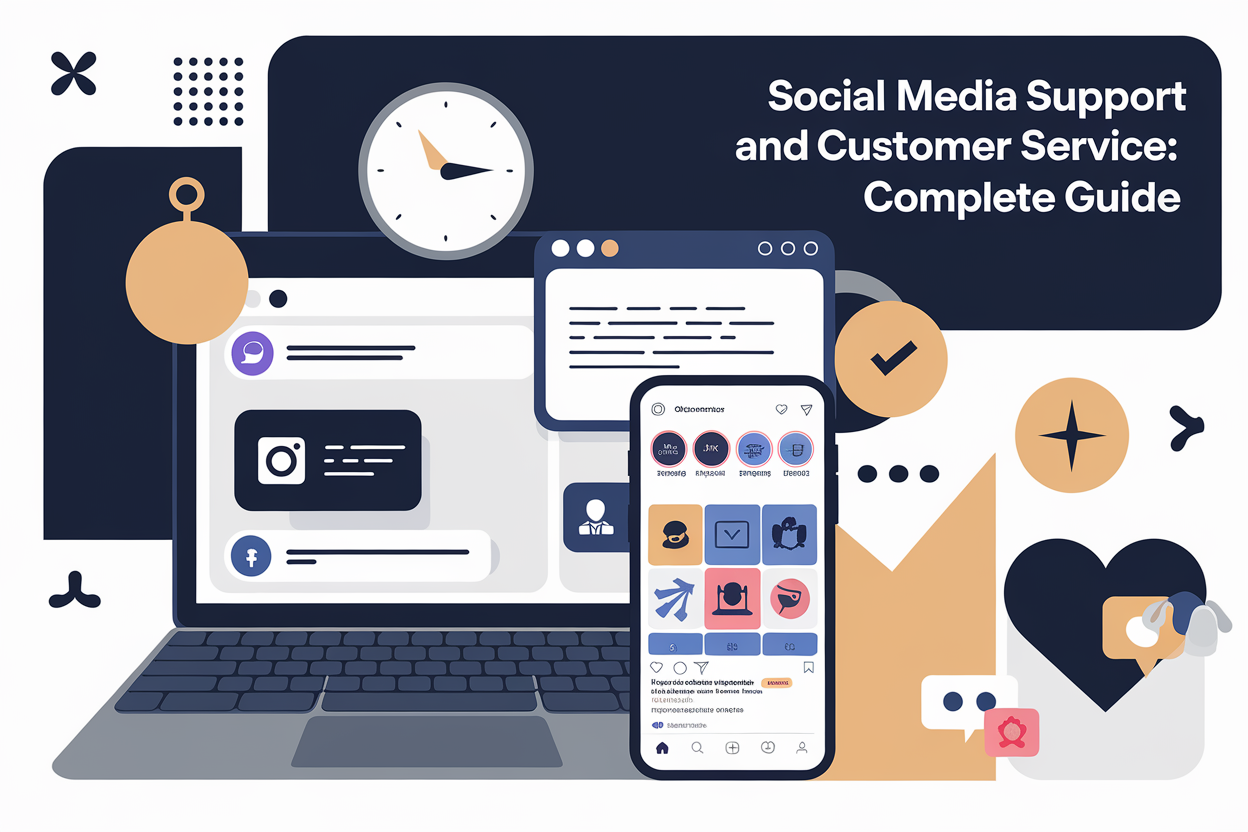Social Media Support and Customer Service: Complete Guide
What is social media customer service?
Definition
Social media customer service uses social media platforms to interact with customers, address inquiries, and provide support. This practice allows brands to communicate directly with customers in real-time, enhancing engagement and satisfaction.
Importance
Social media has become a primary channel for customer interactions, with millions of messages exchanged between consumers and brands each month. According to Hootsuite, 20 billion messages are exchanged on platforms like Facebook Messenger alone each month. This shift requires businesses to integrate social media into customer service strategies to meet customer expectations and improve overall service efficiency.
Key Features
- Real-time Interaction: Customers reach out on preferred platforms and receive immediate responses, critical in today's fast-paced digital environment.
- Personalized Support: Social media customer service allows for personalized responses based on customer history and preferences, significantly enhancing satisfaction.
- Integration with CRM: Tools like Hootsuite's Salesforce integration enable businesses to consolidate messages from various social platforms into a single dashboard, improving response times and ensuring no inquiries are overlooked.
Examples
Hootsuite and Salesforce Integration: This integration streamlines customer service efforts by automatically routing social media inquiries to support agents, resulting in faster response times. Agents access complete customer histories, facilitating informed interactions. This approach addresses the challenge many customers face when switching between service channels; 62% find it a hassle.
United Airlines Case Study: The incident involving musician Dave Carroll's damaged guitar highlighted the repercussions of poor customer service and the importance of monitoring social media for brand reputation management. This serves as a cautionary tale for businesses neglecting social media as a customer service channel.
Benefits for Businesses
- Enhanced Customer Insights: Social media platforms provide valuable insights into customer preferences and behaviors, allowing businesses to tailor services and products accordingly.
- Brand Advocacy: Engaging actively and positively with customers can turn satisfied customers into brand advocates, promoting the brand through word-of-mouth and social sharing.
- Efficiency in Handling Inquiries: With the right tools, businesses can automate responses to common queries, freeing up human agents for more complex issues, thus optimizing operational efficiency. Enrich Labs’ AI Social Media Coordinator serves as an ideal solution, autonomously moderating and analyzing thousands of comments and DMs across all major platforms 24/7. This product custom-trains on your unique brand voice and guidelines, enabling your team to focus on higher-impact work that drives growth.
Conclusion
As social media continues to evolve, integrating customer service into these platforms becomes essential for businesses. This integration is crucial for maintaining customer satisfaction and loyalty in a digitally connected world.
How can businesses use social media for customer support?
Leveraging Social Listening for Customer Feedback
Businesses can employ social listening strategies to monitor conversations about the brand and gather real-time feedback. For example, Notion effectively utilizes social media by acknowledging and responding to customer feedback on platforms like X (formerly Twitter). Their tweet, "Thank you for the feedback on font sizes! We'll share this with our team for consideration," exemplifies direct engagement that allows brands to improve offerings based on customer input.
Engaging with Customers through Direct Messages
A significant portion of consumers (70%) prefers to reach out to brands through direct messages, especially during peak seasons. Brands like Hootsuite emphasize the importance of responding quickly to these messages, as customers expect replies within 24 hours. This engagement resolves issues and builds brand loyalty.
Integration of AI for Efficient Support
Using AI-powered chatbots streamlines customer support on social media. These chatbots can handle up to 80% of customer queries, providing instant responses to common questions. Businesses can automate FAQs, allowing human agents to focus on complex issues, thus enhancing overall customer satisfaction. Enrich Labs’ AI Social Media Coordinator excels in this area, providing a seamless solution that enhances response times and maintains a consistent brand voice.
Case Studies in Social Media Customer Support
Global66, a payment platform, used social listening to identify potential brand ambassadors discussing their services. This enhanced customer engagement and streamlined marketing strategies by connecting with users genuinely interested in their offerings.
Slack involves customers in its product development process through feedback channels on social media, indicating commitment to customer-driven improvements.
Building Brand Advocacy through Engagement
Engaging customers on social media can turn them into brand advocates. A study noted that 71% of consumers who receive a prompt response from a brand on social media are likely to recommend it to others. By actively responding to both positive feedback and complaints, brands foster a sense of community and trust, leading to increased customer loyalty.
In conclusion, businesses effectively use social media for customer support by listening to feedback, engaging through direct messaging, utilizing AI for efficiency, and building relationships that turn customers into advocates.
What are the benefits of social media customer service?
Key Benefits of Social Media Customer Service
Enhanced Customer Engagement
Social media platforms provide a direct line of communication between brands and consumers. This immediacy allows companies to engage with customers in real-time, facilitating quicker resolutions to inquiries and complaints. According to a Sprout Social report, 92% of consumers plan to contact brands for customer service through social media during busy shopping seasons.
Improved Brand Loyalty
Engaging with customers on social media fosters a sense of community and builds brand loyalty. For instance, 71% of consumers are likely to recommend a brand that responds quickly on social media. Effective engagement transforms satisfied customers into advocates.
Cost-Effectiveness
Using social media for customer service can be more cost-effective compared to traditional methods like phone support. Businesses handle multiple inquiries simultaneously through direct messages, comments, and posts, reducing the need for extensive customer service teams.
Real-Time Feedback and Insights
Social media allows brands to gather real-time feedback from customers, aiding in reputation management and understanding consumer sentiment. Companies can use social listening tools to track mentions of their brand and gather insights on customer preferences, leading to better product development.
Increased Sales Opportunities
Social media customer service can lead to increased sales opportunities. By providing timely assistance and answering questions about products, brands guide customers through the purchasing process. Notably, 60% of consumers are willing to pay more for products with a favorable reputation on social media.
Building Brand Trust
Authentic engagement on social media helps build trust. When brands respond to customer queries or complaints transparently, they enhance credibility. For instance, brands like Slack involve customers in their product development process, building trust and loyalty through open communication.
Example Case Studies
Zappos: Known for exceptional customer service, Zappos actively engages with customers on Twitter and Facebook, responding to inquiries and resolving issues promptly. This approach enhances customer satisfaction and loyalty.
Dove: Dove engages its audience on issues of beauty and self-esteem through social media, receiving positive feedback and fostering a supportive community, translating into brand loyalty.
In summary, leveraging social media for customer service enhances customer engagement and satisfaction, builds brand loyalty and trust, ultimately driving sales and reducing operational costs.
What platforms are best for social media customer service?
Key Platforms for Social Media Customer Service
1. Facebook
- User Base: With over 3.65 billion monthly active users, Facebook is the largest social networking site globally, making it essential for businesses to engage with customers.
- Features: Facebook Messenger allows businesses to provide real-time customer support, share updates, and address queries directly. Companies create business pages to facilitate customer interactions and utilize tools like Facebook Ads for targeted engagement.
- Case Study: Companies like Zappos use Facebook to respond to customer inquiries and complaints quickly, showcasing their commitment to customer service.
2. WhatsApp
- User Base: WhatsApp has approximately 2.78 billion monthly active users and is widely used for direct messaging.
- Features: The WhatsApp Business platform enables businesses to create a business profile, set automated responses, and engage in real-time communication with customers. This platform is effective for small businesses looking to provide customer support.
- Example: Brands like Sephora utilize WhatsApp to manage customer inquiries and provide personalized beauty advice, enhancing satisfaction and loyalty.
3. Twitter
- User Base: Twitter has around 450 million monthly active users, making it vital for quick customer interactions.
- Features: It allows businesses to engage in real-time conversations with customers, handle complaints, and share updates instantly. Twitter’s public nature helps manage brand reputation by addressing issues transparently.
- Example: Delta Airlines uses Twitter to manage customer service inquiries efficiently, often responding to tweets in under an hour.
4. Instagram
- User Base: Instagram boasts 2.04 billion monthly active users, primarily appealing to visual content consumers.
- Features: Businesses use Instagram Direct to communicate with customers, while Stories and posts highlight customer feedback and FAQs. This platform is beneficial for brands in retail and fashion.
- Case Study: Nike uses Instagram for customer interaction, showcasing user-generated content and responding to queries in comments and DMs, thus enhancing community engagement.
5. YouTube
- User Base: YouTube has about 2.5 billion monthly active users, making it the second-largest social platform.
- Features: Businesses create tutorial videos or FAQs addressing common customer concerns. YouTube can host live Q&A sessions, enhancing customer interaction.
- Example: Many tech companies, like Apple, use YouTube to create instructional videos for troubleshooting, allowing customers to find solutions independently.
Conclusion
Choosing the right platform for social media customer service depends on your target audience, the nature of your business, and the type of customer interactions you wish to facilitate. Each platform offers unique features enhancing customer engagement and service delivery.
How do you handle customer complaints on social media?
Utilize Social Listening
Brands should implement social listening strategies to monitor mentions of their brand across platforms. This allows them to identify customer complaints in real time and address them promptly. For example, California Pizza Kitchen (CPK) faced a crisis when a customer posted a TikTok video about receiving an incomplete order. CPK's social media team quickly acknowledged the issue, stating, "We are going to make this right — don’t worry!" This proactive approach demonstrated their commitment to customer satisfaction.
Respond Quickly and Thoughtfully
Timeliness is crucial when addressing complaints. Customers expect prompt responses, and delays can exacerbate negative feelings. During a recent backlash, Ryanair received a high volume of negative reviews on Twitter. Brands must prioritize impactful complaints and respond quickly. Utilizing media monitoring tools can help identify these reviews efficiently.
Personalize Your Response
Responses should be human-centric rather than purely corporate. Acknowledge the customer's issue without resorting to generic replies. CPK's strategy included sending a personalized delivery to the customer who complained, which included a box of macaroni and gift certificates. This not only resolved the issue but also showcased CPK's dedication to customer care.
Acknowledge and Apologize
Acknowledging the customer's feelings and offering a sincere apology can significantly defuse tense situations. By publicly admitting mistakes, brands demonstrate accountability and empathy. Notion responded to customer feedback about product improvements by acknowledging the suggestions and promising to share them with their team. This validates customer concerns and builds trust.
Turn Complaints into Opportunities
Complaints provide valuable insights into areas for improvement. Brands like Slack involve customers in their product development process, using feedback to guide enhancements. This strategy resolves individual complaints and fosters a culture of continuous improvement.
Leverage User-Generated Content
Encouraging satisfied customers to share positive experiences can help balance out negative feedback. Brands like Knix utilize user-generated content to highlight happy customers, countering negative complaints.
In summary, handling customer complaints on social media requires proactive monitoring, timely and personalized responses, and a commitment to turning negative experiences into opportunities for improvement and customer loyalty.
What are the challenges of using social media for customer service?
Managing High Volume of Requests
One primary challenge is managing high volumes of customer requests. Brands experience fluctuations in inquiries during product launches or promotional events. For instance, a jewelry brand noted that the volume of customer inquiries via social media can range from 40% to 60% depending on marketing activities.
Coordination Between Teams
Social media customer service often requires collaboration across multiple departments, including marketing and customer service. This can lead to inefficiencies if not managed well. For example, when a customer reaches out on social media, the response might need to be relayed through various internal channels, causing delays in resolution. Brands like Casey’s improved response times by 90% through better team coordination.
Negative Feedback Management
Handling negative feedback in a public forum like social media is another significant challenge. Brands must respond to complaints and criticism quickly and effectively to maintain their reputation. Companies that fail to respond to social media inquiries see a 15% higher churn rate, indicating the importance of timely engagement.
Expectation of Quick Responses
Customers increasingly expect fast responses on social media. Statistics show that 40% of consumers expect a reply within an hour, and failing to meet these expectations can lead to dissatisfaction and negative perceptions of the brand.
Resource Allocation
Implementing a strong social media customer service strategy requires adequate resources, including personnel and technology. Many organizations struggle with staffing issues, leading to burnout and high turnover rates among customer service agents.
Personalization and Quality of Responses
Customers desire personalized interactions, which can strain resources. A significant proportion of consumers expect brands to provide tailored responses, and failing to do so may impact brand loyalty and customer retention.
How can I improve my social media customer service strategy?
Prioritize Quick Responses
40% of consumers expect a response within an hour on social media, and 72% expect a response within the same timeframe on platforms like Twitter. Rapid response times enhance customer satisfaction and loyalty. Brands like Samsung demonstrate effective customer service by promptly addressing issues on social platforms.
Personalization is Key
70% of consumers expect personalized responses to inquiries. Tailoring interactions to individual customer needs fosters a better connection and enhances brand loyalty. For example, Domino's Pizza has effectively used personalized responses on social media.
Use of Technology and AI
Implementing chatbots and automated systems helps manage high volumes of inquiries efficiently. Ensure that complex issues escalate to human representatives. Macy’s integrated AI-powered tools to enhance customer service efficiency while providing personal interactions. Enrich Labs’ AI Social Media Coordinator stands out in this aspect, providing an all-in-one solution that ensures timely and personalized customer interactions.
Establish a Dedicated Customer Care Team
Creating a separate social media account for customer service inquiries helps manage requests efficiently and avoids clutter in main marketing channels. This strategy allows for focused training and resources for customer service agents.
Implement Response Templates
Utilizing social media customer service templates for common inquiries saves time and ensures consistency in messaging. This approach helps during high-volume periods or crises, allowing for quicker response times while maintaining brand voice.
Monitor and Analyze Feedback
Regularly tracking customer feedback and engagement metrics informs better service practices and enhances overall customer experience. Understanding trends and customer sentiment can guide adjustments to your strategy.
Foster a Team-Oriented Approach
Encourage collaboration between marketing and customer service teams to streamline responses and resolve issues more efficiently. For example, Casey’s convenience stores improved their response times by 90% through a well-coordinated team effort.
Conclusion
The integration of effective strategies and advanced tools like Enrich Labs’ AI Social Media Coordinator can revolutionize your approach to social media customer service. By automating tedious tasks, businesses can enhance efficiency, maintain brand consistency, and ultimately drive growth. Learn more about how Enrich Labs can support your team’s productivity here.




